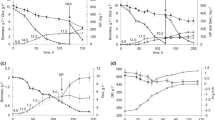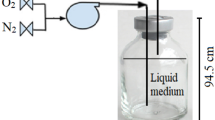Abstract
The metabolism of chloroguaiacols by a soil bacterium was studied. The strain was isolated by enrichment with guaiacol as the sole carbon and energy source, and identified as a Rhodococcus ruber CA16. None of seven chlorinated, guaiacols supported bacterial growth. However, ultraviolet spectroscopy chloride release, and oxygen consumption showed that resting cells grown on guaiacol degraded completely 4-chloroguaiacol 5-chloroguaiacol and 6-chloroguaiacol and, to a lesser extent, 4,5-dichloroguaiacol Gas chromatographic analysis suggested microbial formation of 4-chlorocatechol and 4,5-dichlorocatechol from 4-chloroguaiacol and 4,5-dichloroguaiacol, respectively. Although mono-and dichloroguaiacols did not affect the strain's ability to grow on guaiacol, chlorocatechols completely arrested growth. The role of chlorocatechols in chloroguaiacol metabolism by this guaiacol-degrading bacterial strain is discussed.
Similar content being viewed by others
Literature Cited
Allard A, Remberger M, Neilson A (1985) Bacterial O-methylation of chloroguaiacols: effect of substrate concentration, cell density, and growth conditions. Appl Environ Mecrobiol 49:279–288
Allard A, Remberger M, Viktor T, Neilson A (1988) Environmental fate of chloroguaiacols and chlorocatechols. Water Sci Technol 20:131–141
Allard A, Hynning P, Lindgren C, Remberger M, Neilson A (1991) Dechlorination of chlorocatechols by stable enrichment cultures of anaerbic bacteria. Appl Environ Microbiol 57: 77–84
Apajalahti J, Salkinoja-Salonen M (1986) Degradation of polychlorinated phenols by Rhodococcus chlorophenolicus. Appl Microbiol Biotechnol 25:62–67
González B, Acevedo C, Brezny R, Joyce TW (1993) Metabolism of chlorinated guaiacols by an Acinetobacter junii strain degrading guaiacol. Appl Environ Microbiol 59:3424–3429
Häggblom M (1990) Mechanisms of bacterial degradation and transformation of chlorinated monoaromatic compounds. J Basic Microbiol 30:115–141
Häggblom M (1992) Microbia breakdown of halogenated aromatic pesticides and related compounds. FEMS Microbiol Rev 103:29–72
Häggblom M, Apajalahti J, Salkinoja-Salonen M (1986) Metabolism of chloroguaiacols by Rhodococcus chlorophenolicus. Appl Microbiol Biotechnol 24:397–404
Häggblom M, Apajalahti J, Salkinoja-Salonen M (1988a) O-Methylation of chlorinated para-hydroquinones by Rhodococcus chlorophenolicus. Appl Environ Microbiol 54:1818–1824
Häggblom M, Nohynek L, Salkinoja-Salonen M (1988b) Degradation and O-methylation of chlorinated phenolic compounds by Rhodococcus and Mycobacterium strains. Appl Environ Microbiol 54:3043–3052
Krieg N, Holt G (1984) Bergey's Manual of Systematic Bacteriology, 9th edn. Baltimore: Williams and Wilkins
Kringstad KP, Lindström K (1984) Spent liquors from pulp bleaching. Environ Sci Technol 18:236A-248A
Kröckel L, Focht D (1987) Construction of chlorobenzeneutilizing recombinants by progenitive manifestation of a rare event. Appl Environ Microbiol 53:2470–2475
Neilson A, Allard A, Lindgren C, Remberger M (1987) Transformations of chloroguaiacols chloroveratroles and chlorocatechols by stable consortia of anaerobic bacteria. Appl Environ Microbiol 53:511–519
Neilson A, Allard A, Hynning P, Remberger M (1991) Distribution, fate and persistence of organochlorine compounds formed during production of bleached pulp. Toxicol Environ Chem 30:3–41
Reineke W, Knackmuss H-J (1988) Microbial degradation of haloaromatics. Annu Rev Microbiol 42:263–287
Remberger M, Allard A, Neilson A (1986) Biotransformations of chloroguaiacols, chlorocatechols, and chloroveratroles in sediments. Appl Environ Microbiol 51:552–558
Author information
Authors and Affiliations
Rights and permissions
About this article
Cite this article
Acevedo, C., Brezny, R., Joyce, T.W. et al. Metabolism of mono-and dichlorinated guaiacols by Rhodococcus ruber CA16. Current Microbiology 30, 63–67 (1995). https://doi.org/10.1007/BF00294184
Issue Date:
DOI: https://doi.org/10.1007/BF00294184




